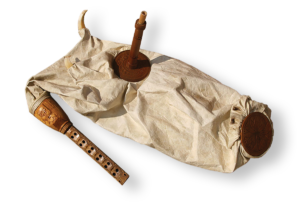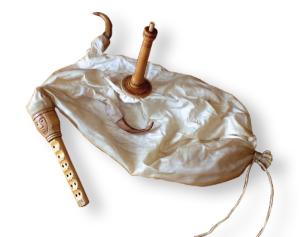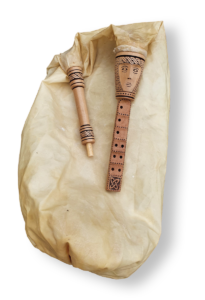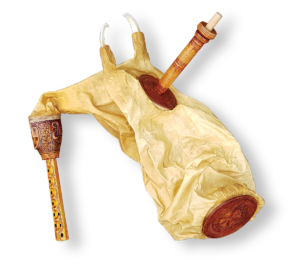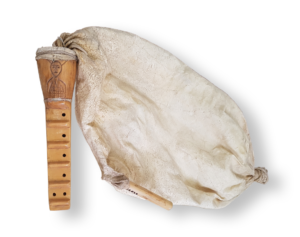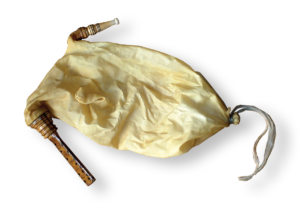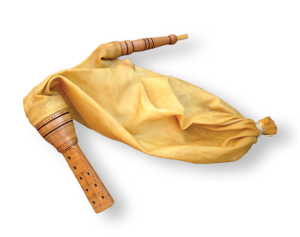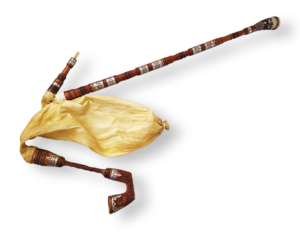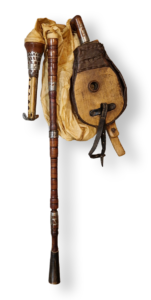BAGPIPE INSTRUMENTS
Glazbala s mješinama
BAGPIPE INSTRUMENTS
Glazbala s mješinama
Glazbala s mješinom su izuzetno stara. Područja drevnih civilizacija su najvjerojatnije ishodišta ovakvih tipova glazbala tako da starost ovih glazbala možemo mjeriti tisućama godina.
Hrvatska je izuzetno bogata raznovrsnim glazbalima s mješinom. Neke varijante glazbala s mješinama su s vremenom nestale, ali dio njih je ostao sačuvan do danas. U našoj narodnoj tradiciji imamo i neke od najstarijih varijanti mihova i dipli koje su, porijeklom, stare i po nekoliko tisuća godina pa do gajdi i duda koje su stare najmanje 800 do 1000 godina.
Razlike između raznih vrsta mihova i dipli nisu tolike u vanjskom izgledu koliko u broju i rasporedu rupica za prebiranje. O tome ovisi stil, tehnika sviranja i ukupan zvuk glazbala.
Musical instruments with a bag are extremely old. The areas of ancient civilizations are most likely the origins of these types of musical instruments, so we can measure the age of these musical instruments by thousands of years.
Croatia is extremely rich in a variety of musical instruments with bag. Some varieties of musical instruments with bag disappeared over time, but some of them have survived to this day. In our folk tradition, we also have some of the oldest varieties of mih and diple, which, by origin, are several thousand years old, up to gajde and dude, which are at least 800 to 1000 years old.
The differences between various types of mih and diple are not so much in the external appearance as in the number and arrangement of holes for playing. The style, playing technique and the overall sound of the musical instrument depend on this.
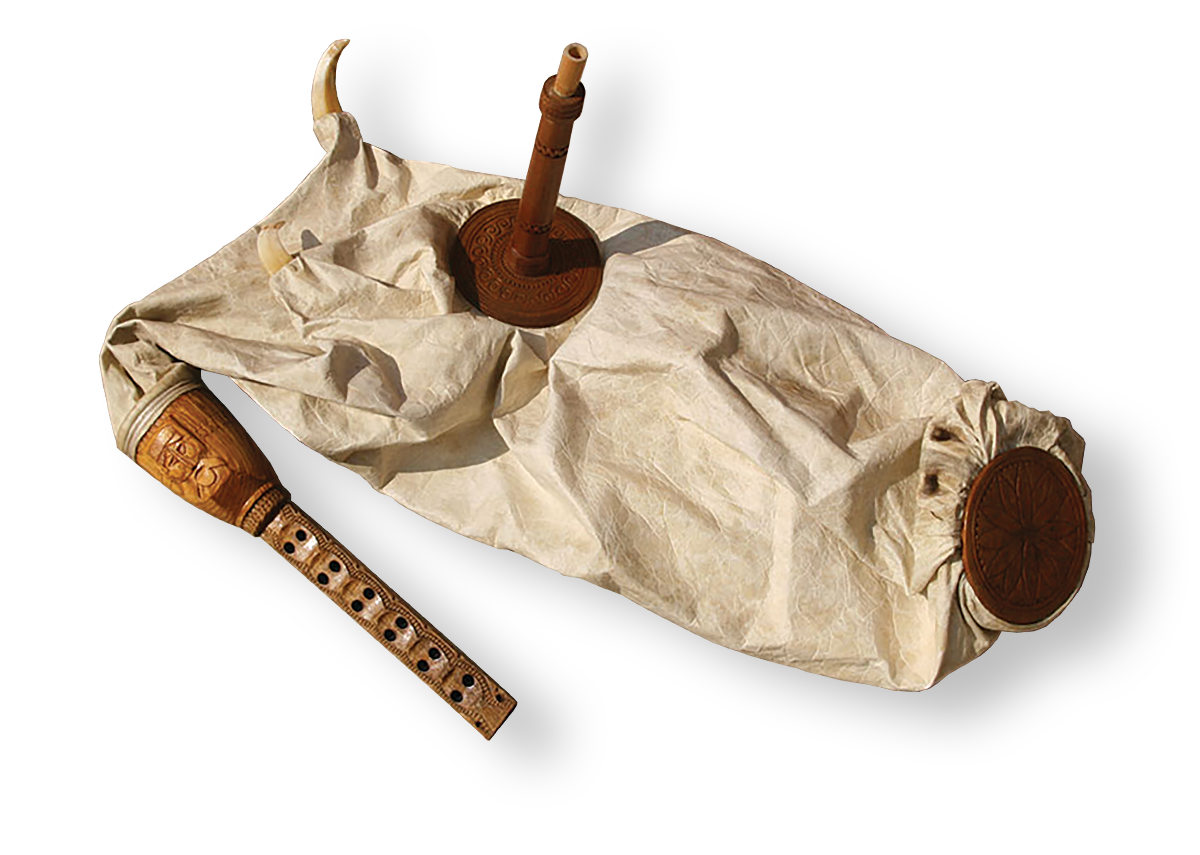
HERCEGOVAČKI MIH
Hercegovački mih se sastoji od štavljene kozje mješine, kutla ili oglavine načinjene od drveta i najčešće izrezbarene u obliku ljudskog lica, a u koju je utaknuta dvostruka drvena svirala s dva piska s jednostrukim udarnim jezičkom od trstike ili bazge. Na svirali su dva reda po (najčešće) šest rupica za prebiranje (6-6). Na sredini mješine je privezana drvena puhaljka ili dulac kroz koju se upuhuje zrak u mješinu. Kao ukras, na mješinu su još privezana dva zuba (kljove domaće svinje ili divljeg vepra), a mogu to biti i drveni pa čak i pravi rogovi (od divokoze ili neke druge životinje s manjim, savijenim rogovima). Na zadnjem dijelu mješine nalazi se drvena, lijepo izrezbarena rotačka.
Hercegovački mih spada u najstarije tipove glazbala s mješinom. Razlika između starijih i novijih tipova je u rasporedu rupica za prebiranje, a kojih na svirali hercegovačkog miha na obje strane ima jednak broj, 6-6. Da su glazbala s mješinom ovakvog tipa rasporeda rupica izuzetno stara ukazuje i činjenica da gotovo indentična glazbala još i danas postoje u nekim zemljama istoka (Grčka, Turska, neka bliskoistočna područja).
MIH FROM HERZEGOVINA
The Herzegovinian mih consists of a tanned goatskin, a barrel or a head made of wood and usually carved in the shape of a human face, into which a double wooden chanter with two pipes with a single reed or elder reed is inserted. There are two rows of six holes on the chanter for playing (6-6). A wooden blower is attached to the middle of the bag, through which air is blown into the bag. As a decoration, two teeth (tusks of a domestic pig or a wild boar) are attached to the mixture, and they can be wooden or even real horns (from a chamois or some other animal with smaller, bent horns). At the back of the mixture there is a wooden, beautifully carved wheel.
The Herzegovinian mih belongs to the oldest types of musical instruments with a bag. The difference between the older and newer types is in the arrangement of the picking holes, which on the Herzegovinian mih chanter have the same number on both sides, 6-6. The fact that almost identical musical instruments still exist today in some eastern countries (Greece, Turkey, some Middle Eastern regions) indicates that musical instruments with a mixture of this type of arrangement of holes are extremely old.
PELJEŠKI MIH
Pelješki mih je rijetko sačuvana varijanta nastarijih mihova i dipli. Vrlo je sličan hercegovačkom mihu i jedina razlika je u rasporedu rupica za prebiranje. Prebiraljka je dvostruka, a raspored rupica za prebiranje na pelješkom mihu je 6-4.
MIH FROM PELJEŠAC PENISULA
Pelješki mih is a rarely preserved variant of older mih and diple. It is very similar to the Herzegovinian mih and the only difference is in the arrangement of the picking holes. The layout of the holes for playing on the mih from Pelješac is 6-4.
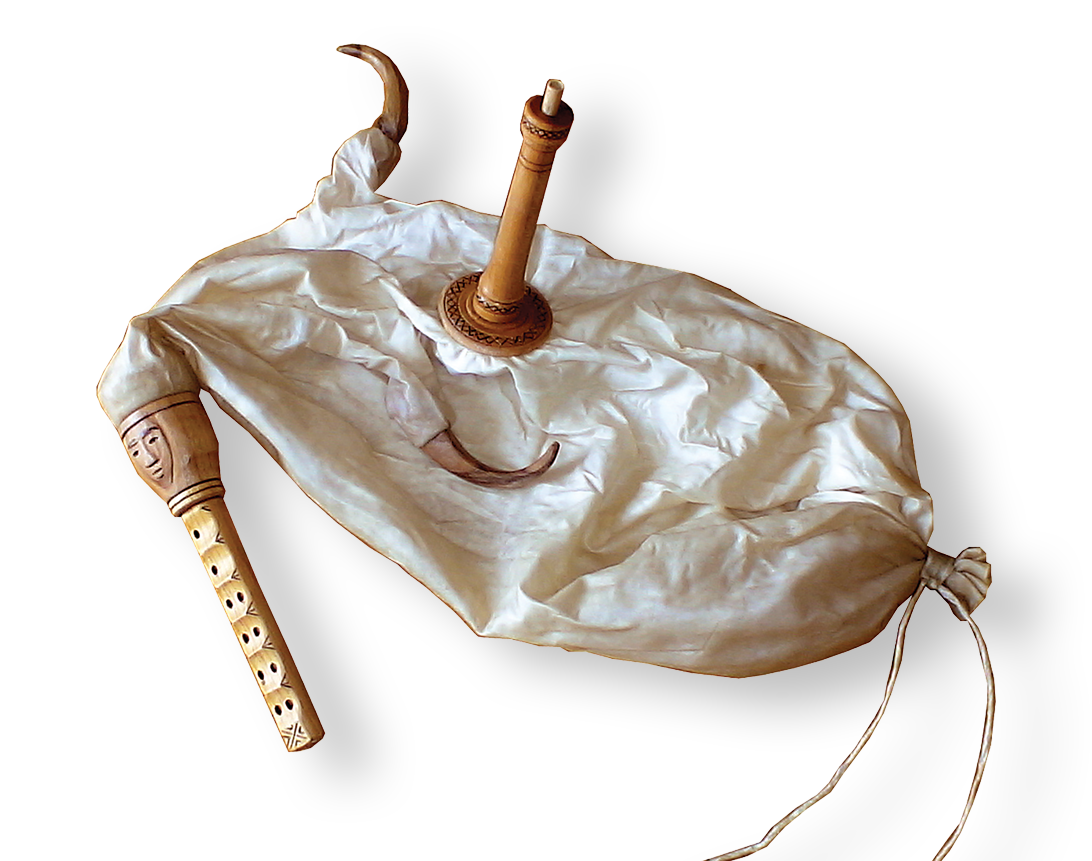

KORČULANSKI MIH
Korčulanski mih može biti po vanjskom izgledu i ukrasima sličan hercegovačkom i pelješkom mihu ili je najčešće malo jednostavnijeg vanjskog izgleda. Jednostavniji oblik se sastoji od štavljene kozje ili ovčje mješine, puhaljke, oglavine i dvostruke prebiraljke s dva piska od trstike. Bez obzira na vanjski izgled i dijelove, najbitnija razlika je u rasporedu rupica na prebiraljci. Korčulanski mih ima na jednoj strani šest, a na drugoj tri rupice za prebiranje (6-3).
MIH FROM KORČULA ISLAND
The Korčula mih has a slightly simpler external appearance than the Herzegovinian and Pelješan mih. It consists of a tanned goat or sheep skin, a blower, a head (barrel) and a double chanter with two reeds. The most important difference is in the arrangement of the holes for playing on the chanter. The mih from Korčula has six holes on one side and three holes for playing on the other (6-3).
DALMATINSKI MIH
Dalmatinski mih je danas najraširenija varijanta starinskih mihova i dipli. Ima mješinu od jareće ili janjeće kože, puhaljku, rogove, rotačku, oglavinu i dvostruku prebiraljku s dva piska od trstike ili bazge. Najbitnija razlika u odnosu na ostale vrste mihova i dipli je u rasporedu rupica za prebiranje kojih kod dalmatinskog miha ima s jedne strane šest, a s druge dvije (6-2).
Kao i kod svih ostalih varijanti mihova i dipli, svaki izrađivač je imao svoj način ukrašavanja i svaki svirač je imao svoju tehniku sviranja što čini veliko bogatstvo hrvatske tradicije.
DALMATIAN MIH
Dalmatian mih is today the most widespread variant of antique mih and diple. It has a goat or lamb skin, a blow pipe, horns, a wheel, a headpiece and a double chanter with two cane or elder reeds. The most important difference compared to other types of mihs and diplas is in the arrangement of holes for playing, which in Dalmatian mih have six on one side and two on the other (6-2).
As with all other varieties of mih and diple, each maker had his own way of decorating and each player had his own playing technique, which is a great wealth of Croatian tradition.
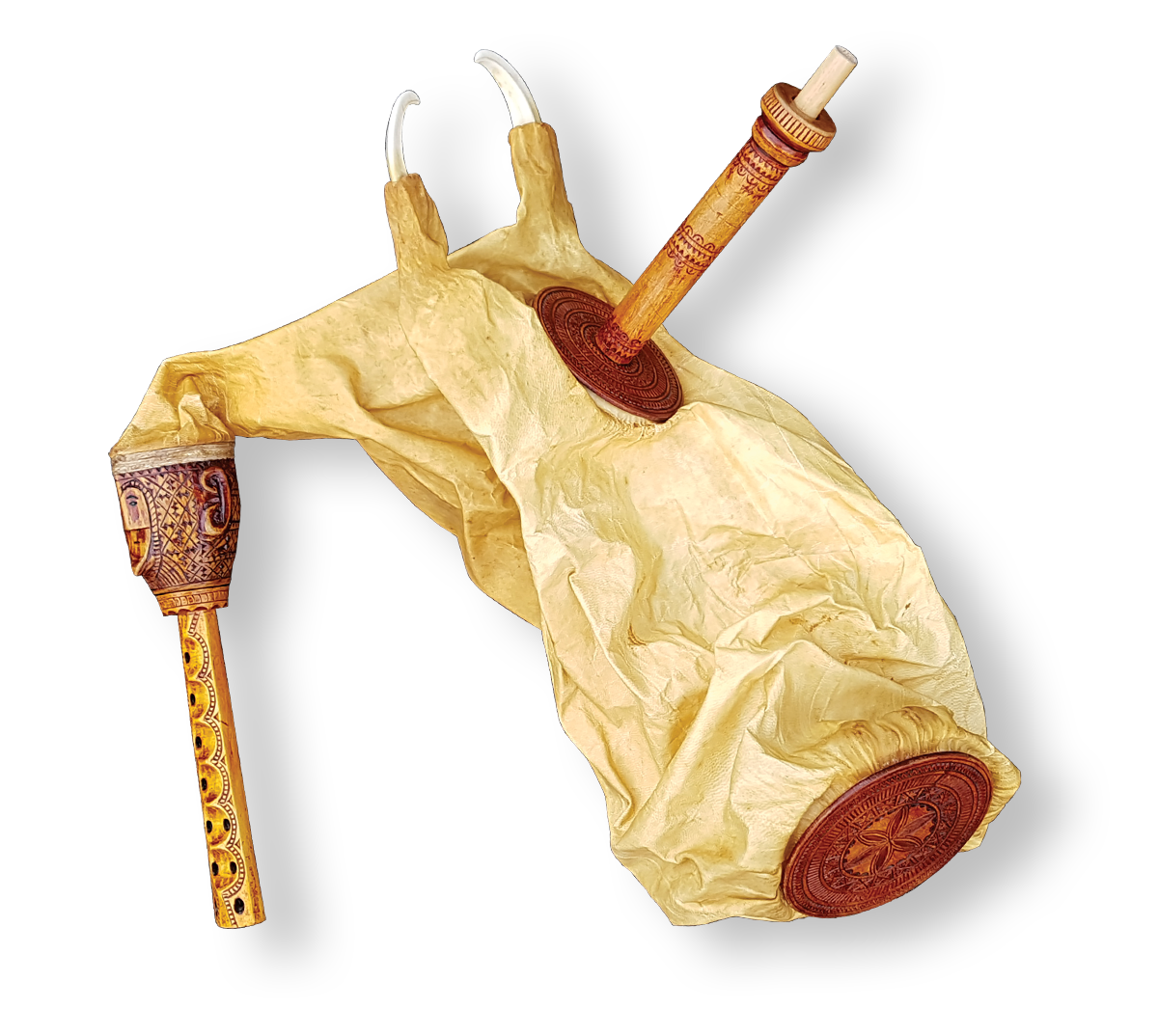
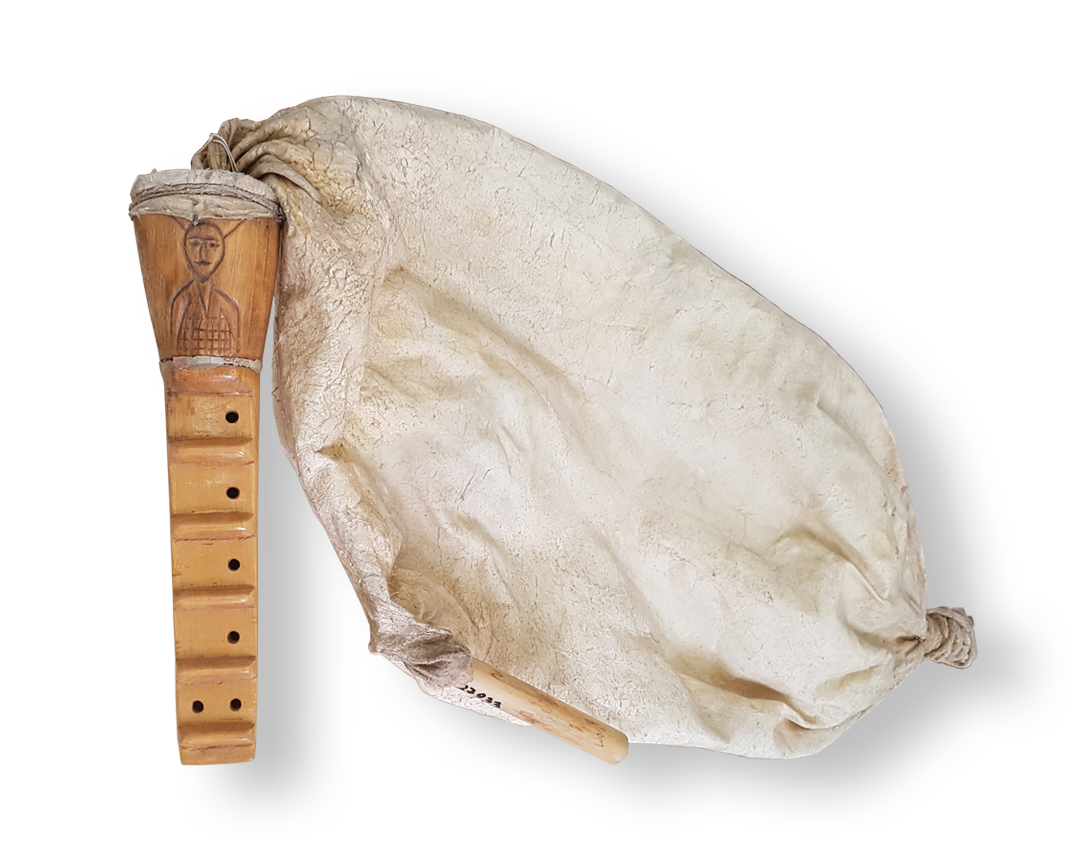
PAŠKI I RAPSKI MIH
Paški i rapski mihovi su jednostavnije varijante dalmatinskog miha. Sastoje se od štavljene kozje ili ovčje mješine, puhaljke, bačvice i dvostruke prebiraljke s dva piska od trstike. Raspored rupica kod paškog miha je 6-2 ili 5-1, a kod rapskog 6-2.
Bez obzira na sličnosti, melodije i tehnike sviranja oba miha su drugačije. Čak i na istom otoku i u istom mjestu, svaki svirač je imao svoj stil sviranja.
MIH FROM PAG AND RAB ISLANDS
Pag and Rab mihs are simpler variants of the Dalmatian mih. They consist of a tanned goat or sheep skin, a blow pipe, a barrel and a double chanter with two reeds. The layout of the holes in Pag mih is 6-2 or 5-1, and in Rab 6-2.
Regardless of the similarities, the melodies and playing techniques of both mihs are different. Even on the same island and in the same place, each player had his own style of playing.
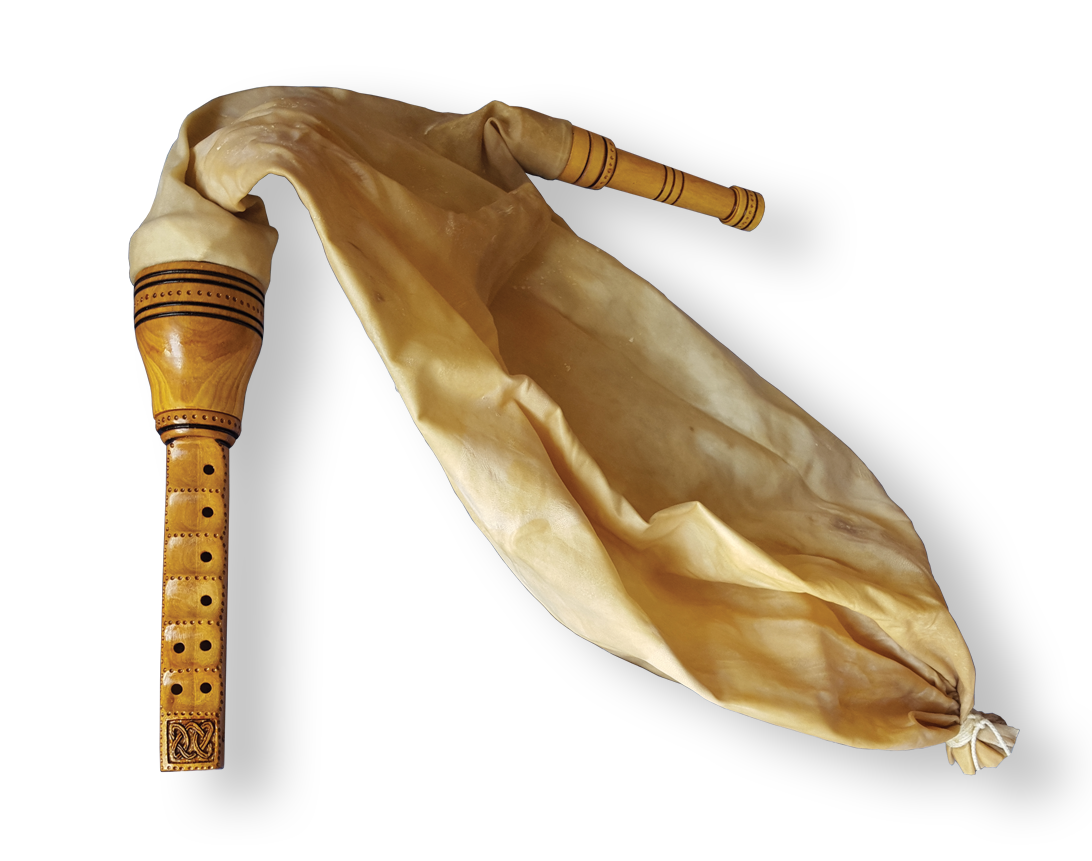
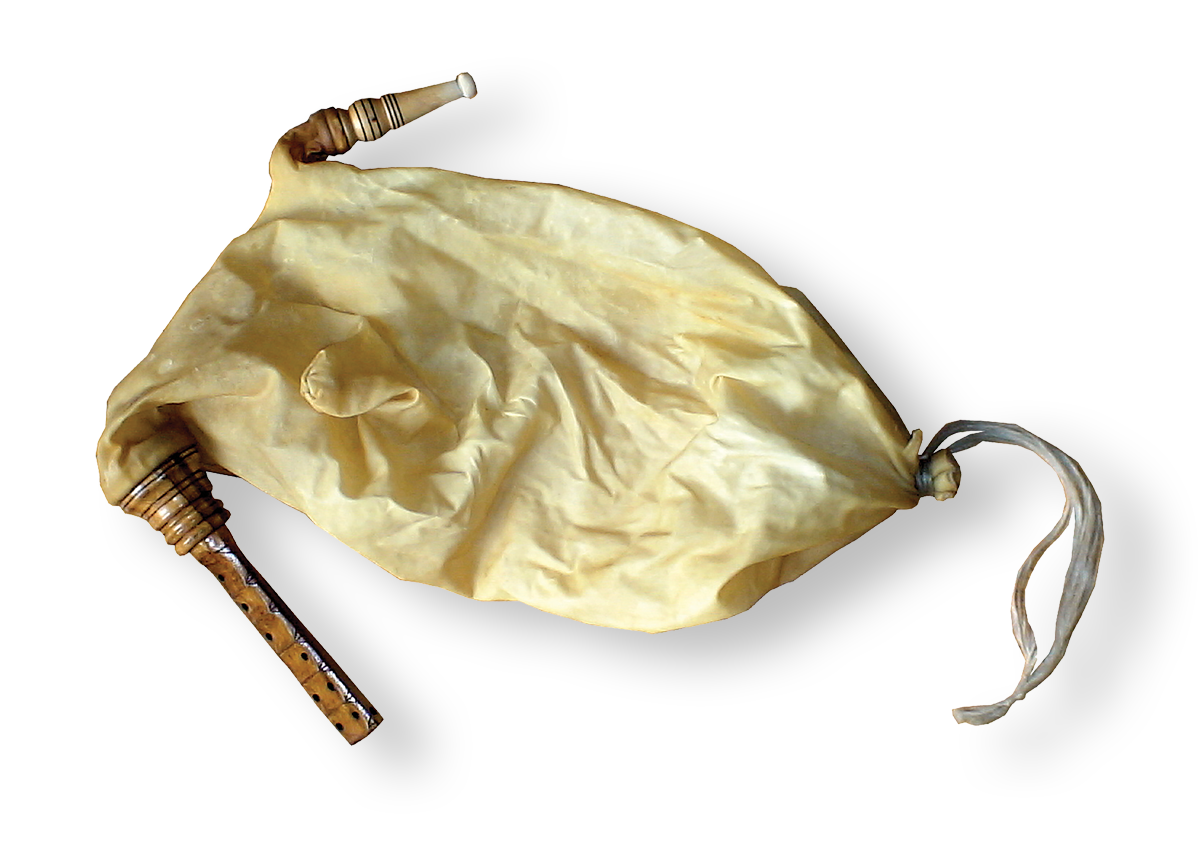
ISTARSKI I CRESKI MIH
Istarski i creski mih su gotovo identični što se tiče osnovnih dijelova i rasporeda rupica za prebiranje. Oba miha se satoje od štavljene kozje ili ovčje mješine, puhaljke, bačvice i dvostruke prebiraljke s dva piska od trstike. Razlika je najviše u tome da je prebiraljka creskog miha duža od prebiraljke istarskog miha pa prema tome ima i nižu intonaciju.
Raspored rupica za prebiranje je sljedeći, na desnoj strani prebiraljke odozgo su tri rupice, u sljedećem redu jedne nema ili je začepljena i onda još dvije. Na lijevoj strani su tri rupice po redu odozdola.
Bez obzira na sličnosti, melodije i stil sviranja oba miha su drugačije.
MIH FROM ISTRIA AND CRES ISLAND
The Istrian and Cres mih are almost identical as far as the basic parts and the arrangement of the holes for playing are concerned. Both mihs are made of tanned goat or sheep skin, a blowpipe, a barrel and a double chanter with two reeds. The main difference is that the chanter of the Cres mih is longer than the chanter of the Istrian mih, so it has a lower intonation.
The layout of the playing holes is as follows, on the right side of the chanter, from above, there are three holes, in the next row one is missing or blocked and then two more. On the left side there are three holes in a row from the bottom.
Despite the similarities, the melodies and playing style of both mihs are different.
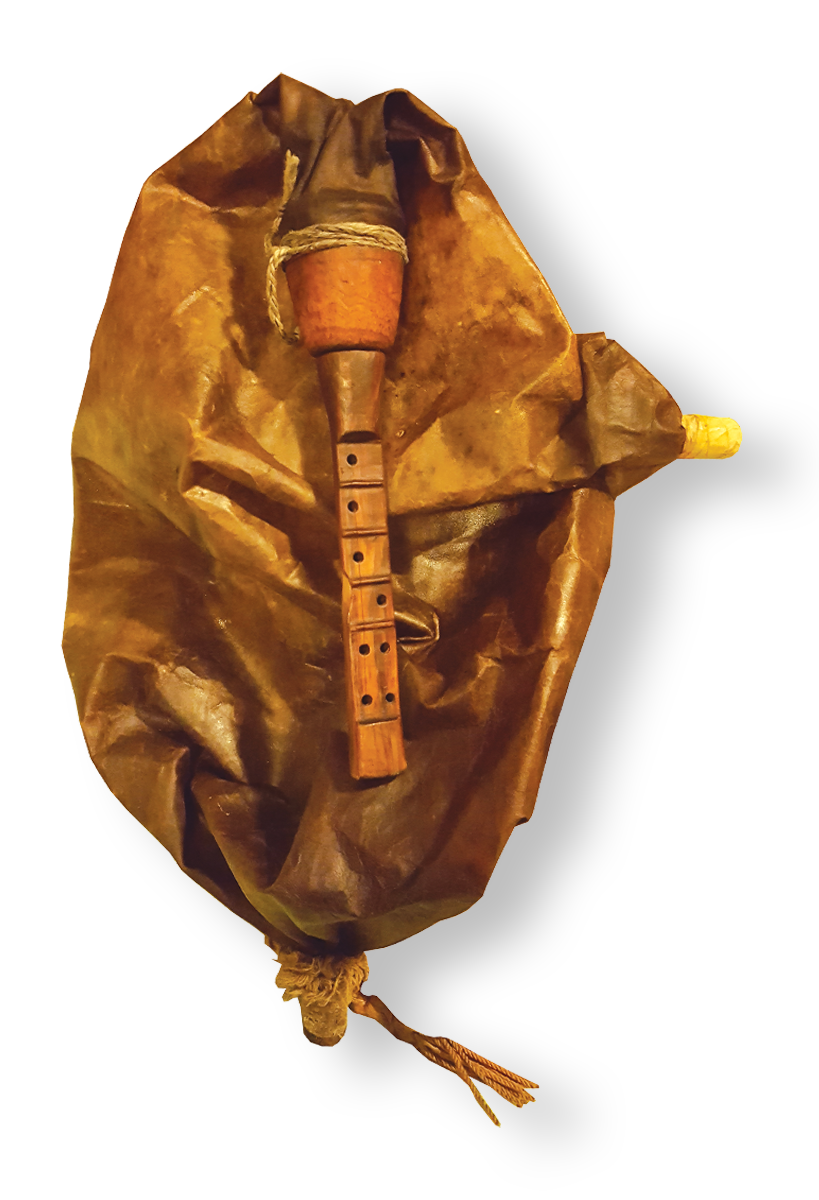

SUSAČKI (PRIMORSKI) MIH
Susački ili primorski mih je vrlo interesantna varijanta starih mihova. Nekada se svirao u nekim primorskim područjima, Kastavštini, rubnim dijelovima Gorskog Kotara i otocima Krk i Susak. Na žalost, na svim tim područjima danas takva vrsta miha više ne postoji. Jednostavn je, sastoji se od štavljene mješine, puhaljke, bačvice i dvostruke prebiraljke s dva piska od trstike. Ono što razlikuje primorski mih od ostalih je raspored rupica za sviranje (5-3) i raspored prstiju na prebiraljci. Za razliku od svih ostalih mihova i dipli gdje su prsti jedne ruke iznad prstiju druge ruke na prebiraljci, kod primorskog miha se rupice poklapaju paralelno (kao na šurlama ili dvojnicama).
MIH FROM PRIMORJE AND SUSAK ISLAND
Mih from island Susak and Primorje (parts of Croatia) is a very interesting variant of old mihs. It used to be played in some coastal areas, Kastavština, peripheral parts of Gorski Kotar and the islands of Krk and Susak. Unfortunately, in all these areas, this type of mih no longer exists today. It is simple, it consists of a tanned animal skin, a blowerpipe, a barrel and a double chanter with two reeds. What distinguishes the coastal mih from the others is the arrangement of the playing holes (5-3) and the arrangement of the fingers on the chanter. Unlike all other mihs and diplas where the fingers of one hand are above the fingers of the other hand on the chanter, in the coastal mih, the holes match parallel (as on shurle or doubleflute).
PIVA
Piva su, ustvari, šurle navezane na mješinu. Sastoji se od mješine, puhaljke, bačvice i dvije odvojene svirale s dva piska od trstike. Piva se svira u malom području Istre (Ćićarija, Galižana). Slično glazbalo se svira i u sjevernoj Italiji, ali su svirale tog glazbala malo duže i najčešće su u prebiraljkama piskovi s dvostrukim jezičkom za razliku od pive gdje su piskovi redovito s jednostrukim jezičkom.
PIVA
The piva are, in fact, shurle attached to the bag. It consists of a animal skin, a blowpipe, a barrel and two separate pipes with two reeds. Piva is played in a small area of Istria (Ćićarija, Galižana). A similar instrument is also played in northern Italy, but the shanter of that instrument is a little longer and most often in the shanter there are double blade reeds, unlike piva where reeds are usually a single blade.
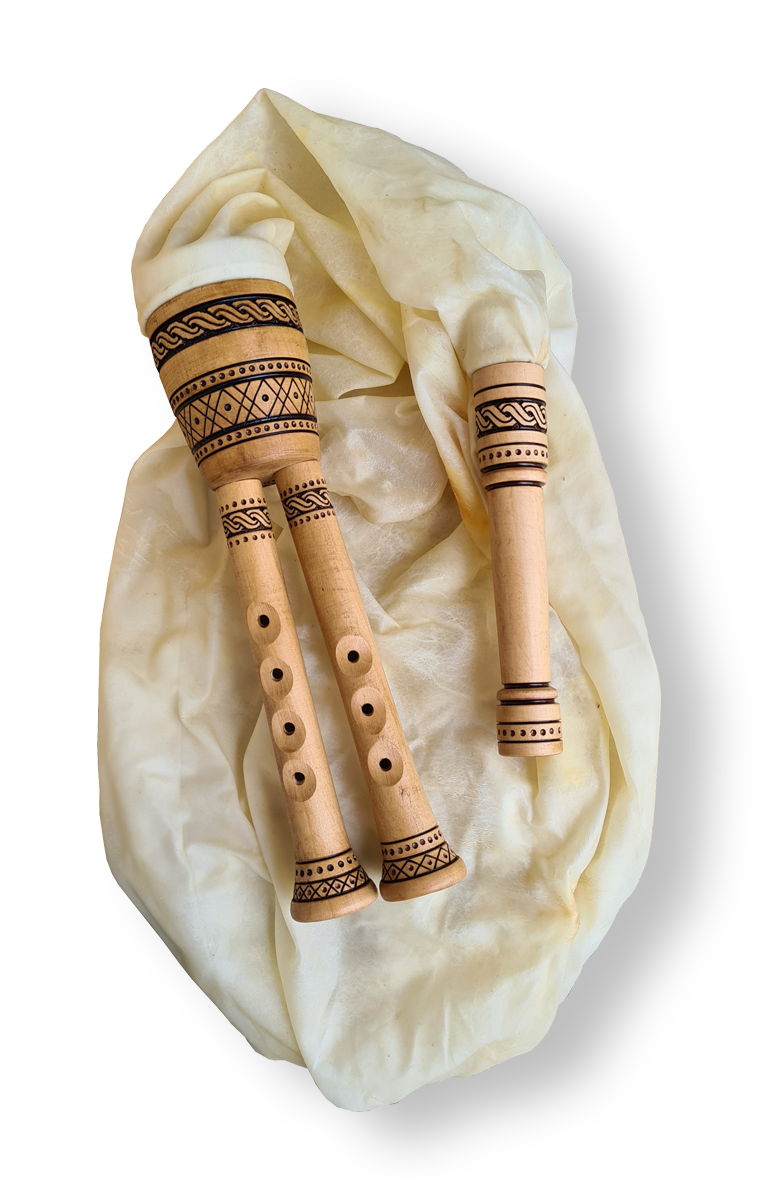
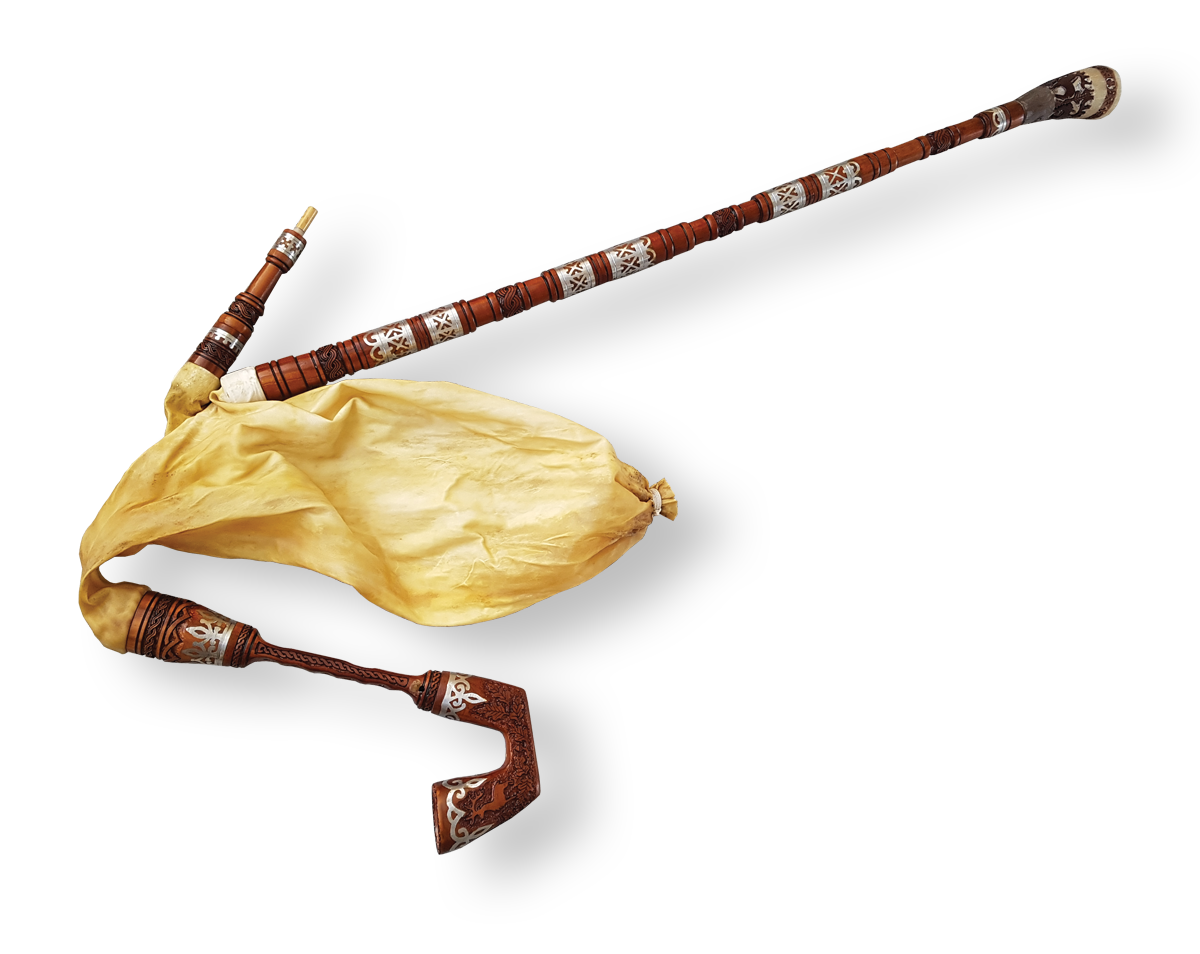
GAJDE
Gajde su vrlo stara glazbala i u raznim varijantama su prisutne u svim zemljama zapadne, srednje i istočne Europe te nekih dijelova Azije. Naše gajde nastale su razvojem od primitivnijih oblika glazbala s mješinom i dvostrukom sviralom kao što su mihovi i diple. Osnovna razlika između gajdi i mihova je u rasporedu rupica za prebiranje, dodavanju roga na sviralu te u trubnju (bordun). Upravo je trubanj tipična odlika gajdi za razliku od svih ostalih glazbala s mješinom. Pretpostavlja se da je današnji oblik gajdi nastao negdje oko 12.-13. stoljeća.
Prebiraljka (gajdunica) naših gajdi je dvostruka, jedna strana je melodijska, a druga služi za ritmiziranje. U prebiraljci se nalaze dva piska od trstike ili bazge i u trubnju jedan.
Gajde se sviraju u Slavoniji, Baranji i dijelu Posavine.
CROATIAN BAGPIPE
Bagpipes are very old musical instruments and are present in various variants in all countries of Western, Central and Eastern Europe and some parts of Asia. Our bagpipes are a development from more primitive forms of instruments such as mihovi and diple. The main difference between bagpipes and diple is in the arrangement of holes for playing, the addition of a horn on the chanter and in the dron (bordun). It is precisely the dron that is the typical characteristic of bagpipes, unlike all other musical instruments with a bagpipe. It is assumed that the present form of croatian bagpipes originated somewhere around the 12th-13th century. century.
The chanter of our bagpipes is double, one side is melodic, and the other is used for rhythmizing. There are two reeds made of reed or elder in the chanter and one in the drone
Bagpipes are played in Slavonia, Baranja and part of Posavina (parts of Croatia).
ČETVEROGLASNE DUDE
Četveroglasne dude su jedno od najizvornijih hrvatskih tradicijskih glazbala, nekada su svirane u velikom dijelu kontinentalne Hrvatske od Zagorja i Međimurja pa sve do središnjeg dijela Slavonije. Sastoje se od sljedećih osnovnih dijelova: mješina, diplice, našak, kvaka, trubanj i puvalak (u novije vrijeme laktača). Mješina je najčešće štavljena kozja koža. Nekada je korištena ovčja i pasja koža. Svi ostali dijelovi su od drveta, često vrlo lijepo ukrašeni olovom ili kositrom, rezbarenim ili paljenim ukrasima.
Posebnost četveroglasnih duda je trostruka prebiraljka te vrlo stari način izrade umetanjem cjevčica u kopanjicu od drveta.
U prebiraljci se nalaze tri piska s jednostrukim udarnim jezičkom od bazge (najčešće) ili trstike.
Laktača (dodatni mijeh kojim se upuhuje zrak u mješinu) se počela koristiti tek početkom 20. stoljeća. Do tada se zrak u mješinu upuhivao ustima preko puhaljke kao i kod svih ostalih glazbala s mješinama.
FOUR VOICED DUDE
Four voiced dude are one of the most original Croatian traditional musical instruments, they were once played in a large part of continental Croatia from Zagorje and Međimurje to the central part of Slavonia. The bag is most often tanned goat skin. Sheep and dog skin were once used. All other parts are made of wood, often very beautifully decorated with lead or pewter, carved or burnt decorations.
The special feature of the four voiced dude is the triple chanter and the very old way of making it by inserting pipes into a wooden shaft.
There are three reeds in the chanter with a single striking tongue made of elder (most often) or reed.
Additional bellows used to blow air into the bag began to be used only at the beginning of the 20th century. Until then, the air was blown into the bag through the mouth through the mouthpiece, as with all other musical instruments with bags.
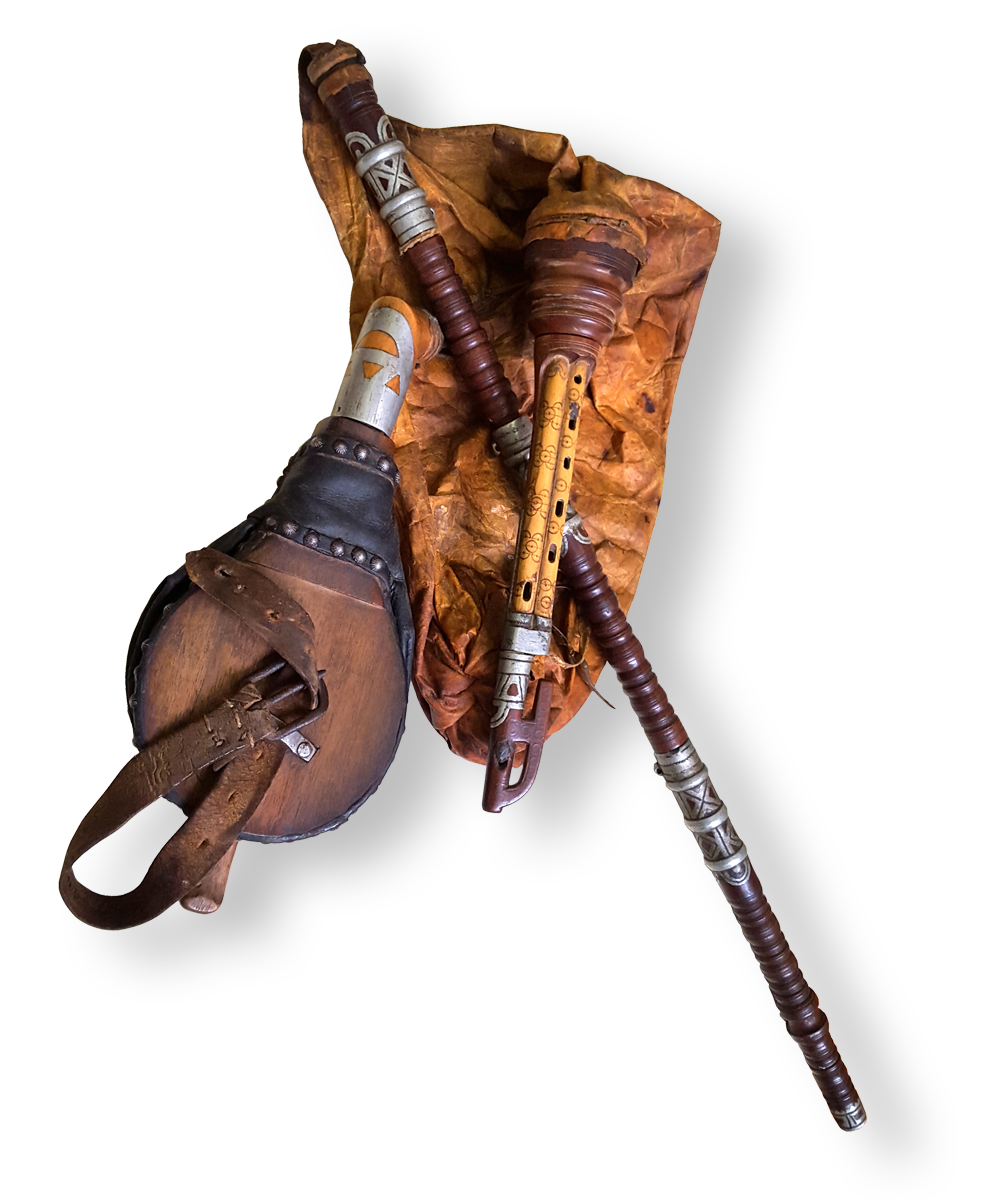
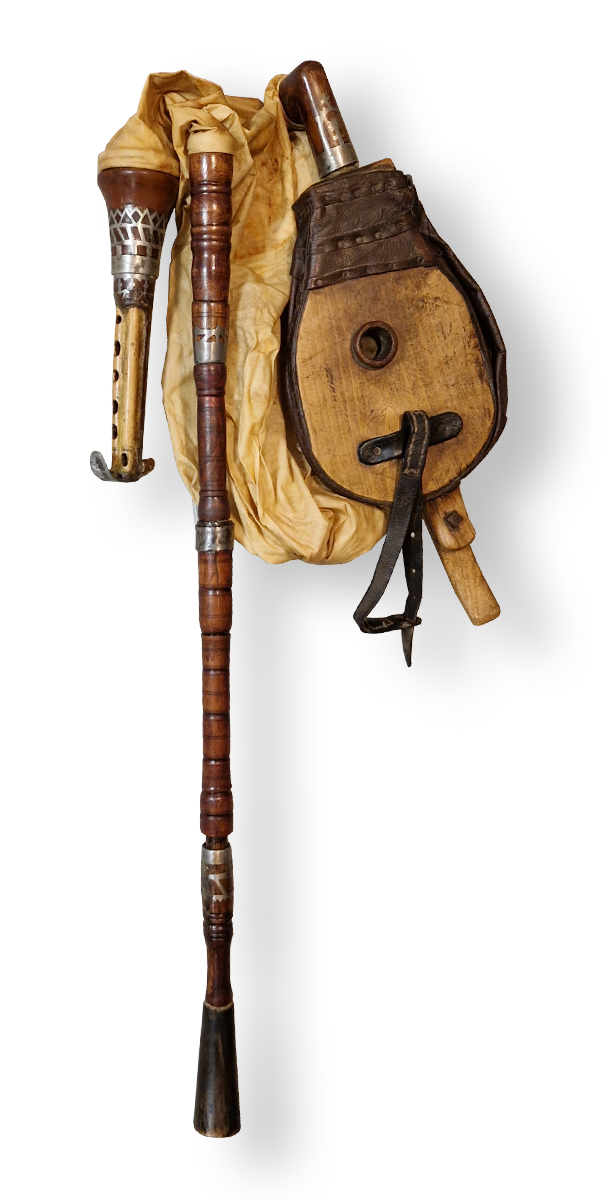
PETEROGLASNE (PODRAVSKE) DUDE
Peteroglasne ili podravske dude su vrlo interesantno i rijetko tradicijsko glazbalo. Za razliku od gajdi koje imaju po dva piska u prebiraljci i četveroglasnih duda koje imaju po tri piska u prebiraljci, peteroglasne dude imaju čak četiri piska u prebiraljci.
Konstrukcija i način izrade prebiraljke peteroglasnih duda je drugačija nego kod gajdi i četveroglasnih duda i kada se na prebiraljci peteroglasnih duda poklope sve rupice za prebiranje, prebiraljka je potpuno zatvorena i ne izlazi nikakav ton. Otvaranjem po jedne ili više rupica za prebiranje istovremeno dobijemo pravo bogatstvo harmonije i zvuka. Može zazvučati do pet tonova istovremeno. Dudaš ima potpunu kontrolu nad svim tonovima prebiraljke. Kod gajdi i četveroglasnih duda to nije moguće.
Upravo zbog toga peteroglasne dude možemo smatrati vrhuncem razvoja hrvatskih tradicijskih glazbala s mješinom.
Peteroglasne dude su nekada svirane u područjima oko rijeke Drave od Podravine, dijelova Slavonije pa do Baranje. U drugoj polovici 20. stoljeća su gotovo nestale, a Hrvati u Mađarskoj još i danas čuvaju tradiciju sviranja ovih duda.
FIVE VOICED DUDE
Five voiced or Podravske dude are a very interesting and rare traditional musical instrument. Unlike croatian bagpipes, which have two reeds in the chanter, and four voiced dude, which have three reeds in the chanter, five voiced dude have as many as four reeds in the chanter.
The construction and method of making the five voiced chanter is different from that of bagpipes and four-voice, and when all the playing holes on the five voiced chanter are closed, the chanter is completely closed and no tone comes out. By opening one or more playing holes at the same time, we get a real wealth of harmony and sound. It can sound up to five tones simultaneously. Player has complete control over all tones of the chanter. This is not possible with bagpipes and four vioced dude.
Precisely because of this, we can consider the five vioced bagpipes as the pinnacle of the development of traditional Croatian instruments with a bag.
Five-voice bagpipes were once played in the areas around the Drava River from Podravina, parts of Slavonia to Baranja. In the second half of the 20th century, they almost disappeared, and Croats in Hungary still preserve the tradition of playing these bagpipes.
INFORMACIJE
Ovo su samo najosnovnije informacije o pojedinim glazbalima. Za sve detaljnije informacije slobodno nam se obratite.
KONTAKT:
Stjepan Večković
CENTAR ZA TRADICIJSKA GLAZBALA HRVATSKE
CENTRE OF CROATIAN TRADITIONAL INSTRUMENTS
Email: gajde.hr@gmail.com
Mob: +385 98 275 211
INFORMATION
This is only the most basic information about individual musical instruments. Feel free to contact us for more detailed information.
